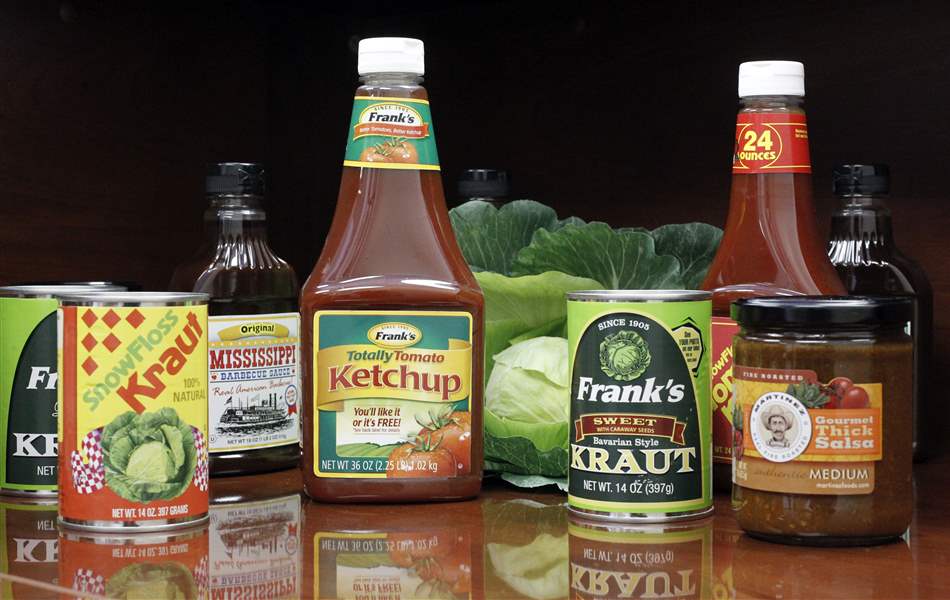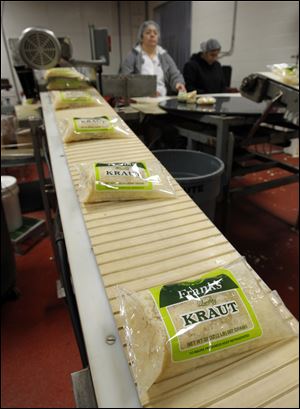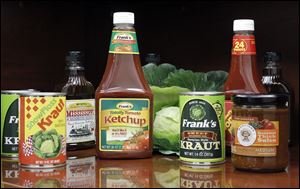
Fremont Company supplies sauerkraut to the Midwest and beyond
2/19/2013
Various products produced by the Fremont Co.
The Blade/Andy Morrison
Buy This Image

Bags of Frank's Kraut come off the line at the Fremont Co.
FREMONT — Back in the day, most towns in northern Ohio had a company that made sauerkraut.
The conditions were perfect for it: a large population from central and eastern Europe, combined with a climate and soil that are particularly suited for growing cabbage. The result? Sauerkraut everywhere.
Over time, though, most of those companies closed down or merged with others. Only the strongest survived — and perhaps those with the best kraut.
The Fremont Company, located in this town along the Sandusky River, is one of the survivors, churning out fermented tons of the stuff every day and making Fremont one of the sauerkraut capitals of the Midwest. While the family-run company does not release specific information about its production, plant manager Bruce Hanzel said that when it is packing the kraut into 2-pound bags, it makes enough to fill two semi-trailers every day.
The company’s two biggest brands are Snow Floss, which was created by company founder Al Slessman in 1905 when he merged several regional kraut makers, and Frank’s, which was acquired a few decades later.
Each brand has its fans, and “people will swear it tastes different,” according to marketing manager Katie Smith Peterson. But the truth is, it’s all the same kraut. It’s made the same, it’s packed the same. The only difference is the label. Each brand is distributed where it does the best: Snow Floss mostly goes to Pennsylvania and a few other states while Frank’s goes to most of the rest of the Midwest, where it is the best-selling brand, Mrs. Peterson said.
In concept, making sauerkraut is easy. Simply slice or shred cabbage, add salt, and wait for the salt to draw liquid out of the cabbage, creating a brine. Then let it sit in an airtight environment while the cabbage ferments in the brine. This process creates lactic acid, which gives the kraut its familiar sour taste.
The trick lies in getting the right ratio of salt to cabbage, in trimming the cabbage correctly, and in knowing how long to let it ferment, Mr. Hanzel said. On average, the Fremont sauerkraut takes around 30 days, depending on the ambient temperature, but it can take as little as 20 days.
The quality of the cabbage is also important, Mr. Hanzel said. The cabbage used in Fremont is all grown within 30 miles of the plant.
But The Fremont Company is more than just sauerkraut. Over the decades, it has become partners with other companies, producing and distributing (and sometimes eventually owning) their food brands.
For instance, Norm Vaughn was a truck driver from Delta whose routes took him up and down the Mississippi River. He loved the ribs and barbecue he ate along the way, but he could never find a bottled sauce that had the exact flavor he craved. So he decided to create his own in 1991, dubbing it Mississippi Barbecue Sauce. It was so popular that he wound up selling his company to The Fremont Company, which now manufactures and distributes it in four flavors (original, sweet ‘n’ mild, sweet ‘n’ spicy, and sweet apple).
Mr. Vaughan retired several years ago and moved to Mexico, said Mrs. Peterson.
In much the same way, Lemix cocktail mixers came to Fremont. The company was founded in Canton, where it made concentrated syrups to mix with alcohol — sweet and sour mix, margarita mix, piña colada mix, and the like. The profitable company, which is particularly popular in Ohio, was looking for an organization to run it with expertise in food production, sales, and distribution. The Fremont Company fit the bill, and now makes cocktail mixers at a remote location.

Various products produced by the Fremont Co.
The most recent partnership is also perhaps the company’s most unexpected. For the last two years, the sauerkraut giant has also been selling Martinez brand salsas. Thicker than most salsas that primarily rely on tomatoes, the Martinez brand is full of minced, flame-roasted Hungarian and Anaheim peppers. The recipe is genuinely Mexican, Mrs. Peterson said, and has been in the Martinez family for five generations. They made it in a factory in Toledo.
Lillian Martinez Katko and her husband, Mark Katko, approached The Fremont Company to become partners. Their salsa is still made in the Toledo factory, but is now sold throughout the eastern United States.
But if The Fremont Company is most associated with anything other than sauerkraut, it is ketchup, which it makes in a plant in Rockford, southwest of Van Wert. From that site comes ketchup in the familiar brands of Frank’s and Snow Floss, but most of its product is made for private labels. When grocery stores want to sell their own brand of ketchup but don’t have the facilities to make it, they contract with companies such as The Fremont Company to make it for them.
The private-label business extends to other of the company’s products, too, including sauerkraut. Although company officials do not discuss the names of the companies for whom they make private-label products, if you buy a can or a bag of sauerkraut with a grocery store’s own label on it, there is a good chance it came from The Fremont Company.
And it will taste exactly the same as Frank’s and Snow Floss, too, although there is a difference in the kraut that comes in a bag and the kraut that comes in a can. To make it easier to be packed, the sauerkraut that comes in a can is cooked first. That makes the cabbage softer and mellows the flavor. The sauerkraut that comes in a bag — or an individual portion for hot dog stands and ballparks — is crisper and crunchier; its what a deli puts on a reuben sandwich.
The company has been making its sauerkraut in the same way for more than 100 years — no one is certain now, but it may even ferment in some of the original, enormous oak vats. The technology for canning and packaging has improved, and so has the quality control: Each batch is checked every hour as it is packed for things like bacteria and salinity.
But it tastes the same as it always has, a fact that brings pride to the fourth generation of family members running the company.
Mrs. Peterson, who is herself a member of the family, said, “I can’t tell you how many people tell me, ‘My grandmother bought this. Now I make it for my kids.’”
Contact Daniel Neman at: dneman@theblade.com or 419-724-6155.